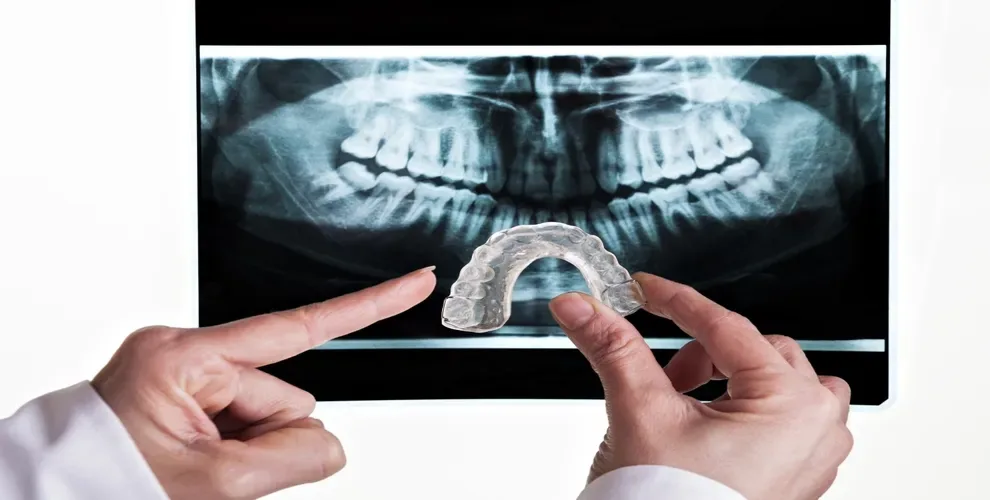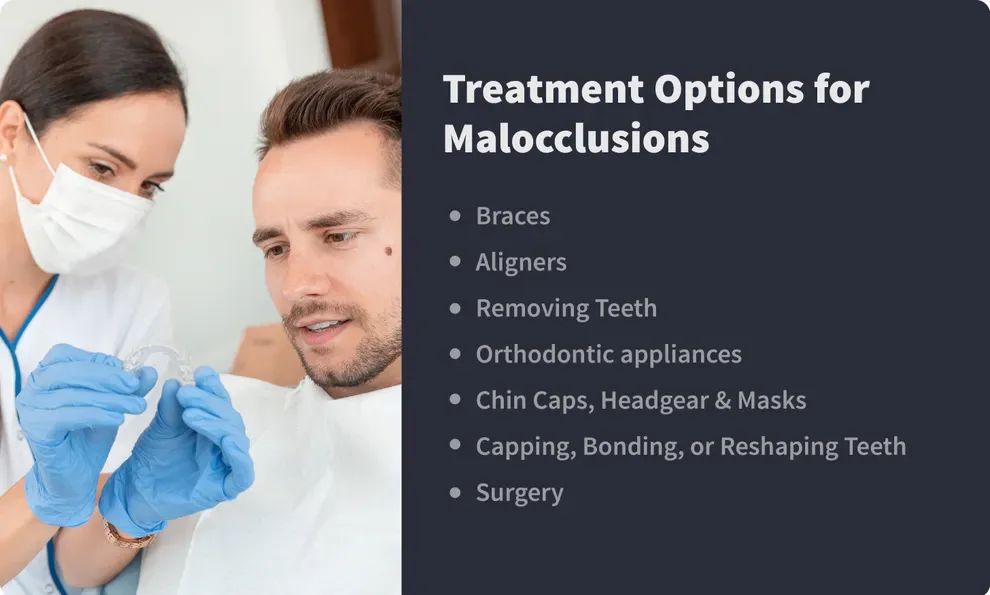Malocclusion Treatment

Table of Contents
- Health Risks of Malocclusion
- Treatment Options
- Types of Malocclusions
- Why use Byte?
A malocclusion is a teeth misalignment, sometimes called a bad bite. Malocclusion is common and includes conditions like overbite, underbite, crossbite, and open bite.
Misalignments can often be seen when an individual talks or smiles. Other signs of malocclusion include crowded teeth, gaps in teeth, and problems eating and speaking.
Many cases of malocclusion are caused by genetics. Childhood oral behaviors (like pacifier use or thumb sucking), tongue thrusting, jaw grinding, poorly fitting dental appliances, injury, and extra or missing teeth may also cause malocclusion.
Some severe cases of malocclusion may require jaw surgery or the removal of teeth. Braces are a popular type of orthodontic treatment for the correction of malocclusion. Orthodontic devices, like palatal expanders and headgear, may also be used.
For mild-to-moderate cases of misalignment, clear removable aligners may be a convenient and fast treatment option.
Health Risks of Malocclusion
Malocclusion can have a serious impact on an individual’s health and well-being. With teeth misalignment, the teeth don’t line up properly. This can cause crowding or gaps in the teeth as well as bad bite patterns that can wear on the teeth and jaw muscles.
The effects of malocclusion can include the following:
Crowding can create narrow passageways between teeth that are hard to clean. Gaps can create open gum areas that are vulnerable to bacteria and buildup. These issues can ultimately lead to decay, gum irritation, and even tooth loss.
Abrasion between misaligned teeth can wear on tooth enamel, weakening the tooth structure and making it more susceptible to damage and decay.
Individuals with malocclusion may feel self-conscious about their appearance and smile. This lack of confidence can affect their personal and professional life as well as their mental health.
Malocclusion can put stress on the jaw and surrounding muscles, resulting in jaw disorders like TMJ.
Misalignment can cause problems with talking, including lisps.
Malocclusion may make chewing, biting into food, and/or swallowing difficult.
Mouth breathing can cause sleep disorders, dry mouth, and an increased risk of tooth decay.
What are the Treatment Options for Malocclusion?

Treatment options for malocclusion will depend on the severity and complexity of the problem. In many cases involving severe malocclusion, there may be more than one type of treatment used.
These are possible treatment options:
If a malocclusion is caused by the positioning of the jaw, surgery may be needed, particularly in cases involving adults. Adult jaws are already formed and harder to influence with orthodontic appliances.
If crowding is present, an orthodontic treatment plan may include tooth removal to ensure there is enough space for teeth to shift into correct positioning.
Through a bracket-and-wire system that’s continually tightened by a dentist or orthodontist, braces apply continuous gentle pressure on the teeth to move them and correct malocclusion. Braces treatment for serious malocclusion may take two years or longer.
Because adult jaws are already developed and harder to influence, orthodontic appliances like headgear (a device that involves wiring inside and outside of the mouth) and a palatal expander (which is applied to the roof of the mouth and expanded to widen the jaw) are not as commonly used, but they may be a part of treatment.
Clear aligners are removable and fit over teeth. With clear aligner treatment, a series of aligners is designed, each with subtle pressure points and bite changes that guide teeth through a gentle progression to proper alignment.
Each tray is worn for a week or two. After the last tray is finished, teeth are in place.
Types of Malocclusions
There are three classes of malocclusion:
With Class 1 malocclusion (the most common type of malocclusion), an individual has a normal bite, but the upper teeth go slightly too far over the lower teeth. Misalignment may be present, with issues like crossbite, tooth rotation, crowding, gaps, and other irregularities.
Treatment options may include braces or clear aligners. Tooth removal may be needed if crowding is severe and will block orthodontic treatment.
Class 2 malocclusion is sometimes called retrognathism or overbite. It occurs when the top teeth and jaw sit too far over the lower teeth and jaw.
Class 2 malocclusion is further categorized into two divisions:
Class 2, Division 1 malocclusion: The upper teeth protrude over lower teeth or are tilted forward. This is sometimes called overjet teeth or buck teeth.
Class 2, Division 2 malocclusion: The upper teeth overlap lower teeth and are tilted toward the roof of the mouth, causing a deep overbite or deep bite.
Class 2 malocclusion may require jaw surgery if the overbite is related to jaw placement (skeletal overbite). Tooth removal may be required if crowding is present. Teeth misalignment will also need to be treated with braces or clear aligners, sometimes in conjunction with orthodontic devices.
Class 3 malocclusion is called underbite or prognathism. With this type of misalignment, the lower jaw sits forward, beyond the upper jaw. The lower teeth and jaw will overlap the upper teeth and jaw.
Class 3 malocclusion caused by the lower jaw protruding forward (skeletal underbite) usually requires jaw surgery and, in cases involving crowding, may require tooth extraction. The misalignment of teeth will require additional treatment: braces or clear aligners, sometimes with the use of orthodontic devices as well.
Why use Byte for Malocclusion Treatment?
For individuals looking to treat mild-to-moderate cases of malocclusion, clear aligners offer many advantages over braces treatment. Not only are they removable and invisible, but they work more quickly and don’t require multiple trips to the orthodontist for uncomfortable adjustments.
When it comes to clear aligners, you also have choices. In-office clear aligner programs operate similarly to traditional orthodontic treatment plans. You’ll meet with a dentist or orthodontist and have regular in-office visits to check in and receive new aligners.
At-home clear aligners offer a more modern and individual approach, allowing for more self-directed care, affordable pricing, and hassle-free treatment.
When it comes to mail-order clear aligners, Byte is a clear leader in the market, offering customers these benefits:
Competitive, straightforward pricing ($2,099 as a one-time fee; payment plans are also available for $90 or less a month)
A completely at-home experience for the ultimate in convenience
Average treatment time of 4–6 months
An award-winning app that allows you to track your progress and communicate with your support team
Doctor-monitored treatment with virtual check-ins to ensure your treatment is on track
A science-backed HyperByte massage device included free with every aligner kit, which may improve comfort and result speed1
Byte for Life guarantee
If you’re not sure that clear aligners will work to correct your malocclusion, you can take Byte’s 30-second assessment and order an easy-to-use at-home impression kit. If it’s determined that you’re not a candidate for aligners, Byte will refund you.
